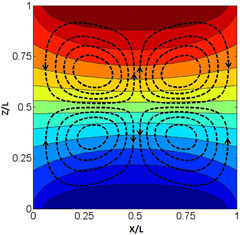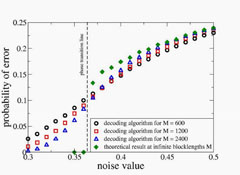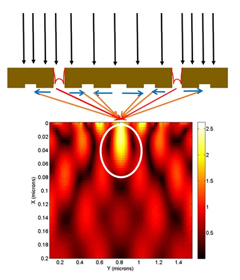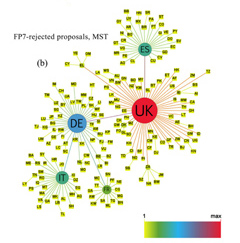Thermodiffusion in weightlessness (Vol. 46 No. 1)

Credit: Y. Gaponenko et al.
Thermodiffusion, also called the Soret effect, is a mechanism by which an imposed temperature difference establishes a concentration difference within a mixture. Two recent studies provide a better understanding of such effects. They build on recent experimental results from the IVIDIL—Influence Vibration on Diffusion in Liquids—research project performed on the International Space Station under microgravity to avoid motion in the liquids.
In the first study, using a mathematical model the authors set out to identify how vibrations applied to a binary liquid mixture change the temperature and concentration fields over a long time scale. Their findings—if extended to ternary mixtures—have implications for models used to evaluate the economic value of oil reservoirs.
The second paper use numerical models to study the establishment of the concentration field near the critical region, where diffusion strongly diminishes. Surprisingly, the authors demonstrate that the component separation through the Soret effect is saturated and not infinite, and is reached surprisingly rapidly. The findings of this study may help determine whether the Soret effect could lead to a very large accumulation of sulfur dioxide and hydrogen sulphide capable of creating a leak in the cap-rock of a reservoir, during the process of capturing CO2 and reinjecting it in supercritical state in such a reservoir.
Y. Gaponenko, A. Mialdun and V. Shevtsova, “Experimental and numerical analysis of mass transfer in a binary mixture with Soret effect in the presence of weak convection”, Eur. Phys. J. E 37, 90, (2014)
[Abstract]
J.C. Legros, Yu. Gaponenko, T. Lyubimova and V. Shevtsova, “Soret separation in a binary liquid mixture near its critical temperature”, Eur. Phys. J. E 37, 89 (2014)
[Abstract]
On-demand conductivity for graphene nanoribbons (Vol. 46 No. 1)

Credit: D. Babajanov et al.
The authors have devised a theoretical model to tune the conductivity of graphene zigzag nanoribbons using ultra-short pulses.
Physicists have, for the first time, explored in detail the time evolution of the conductivity, as well as other quantum-level electron transport characteristics, of a graphene device subjected to periodic ultra-short pulses. To date, the majority of graphene studies have considered the dependency of transport properties on the characteristics of the external pulses, such as field strength, period or frequency. These results may help to develop graphene-based electronic devices that only become conductors when an external ultra-short pulse is applied, and are otherwise insulators.
Specifically, they found that applying external driving force leads to enhancement of electronic transitions within valence and conduction bands. This study thus demonstrates that such transitions allow a dramatic increase in conductivity within a short time, making it possible to tune the electronic properties using short external pulses.
D. Babajanov, D.U. Matrasulov and R. Egger, “Particle Transport in Graphene Nanoribbon Driven by Ultrashort Pulses”, Eur. Phys. J. B 87, 258 (2014)
[Abstract]
Small-worlds to analyze error-correcting codes on memory channels (Vol. 46 No. 1)

Low-density parity-check (LDPC) codes invented by Robert Gallager are error-correcting schemes that form the basis of today’s most promising communication systems. Their performance not only approaches Shannon’s theoretical bound, but they are based on computationally efficient encoding/decoding schemes.
While the literature behind LDPC codes is vast, it is based mostly on LDPC codes on channels without memory, i.e. channel noise acts independently on every bit. Memory in the channel noise is however a practical fact: e.g. the noise in wireless communication due to a moving source.
We have shown that decoding algorithms for LDPC codes on channels with memory can be analyzed using statistical mechanics. Memory introduces an extra set of degrees of freedom and the decoding problem becomes equivalent to studying phase transitions on `small-world’ networks. In this mapping the ferromagnetic-paramagnetic transitions represents the transition from success to failure of reliable communication.
Using replicated transfer matrices we derived the corresponding density evolution equations which determine the decoding performance at infinite block lengths (see figure). The theoretically derived critical values agree well with the practical implementation of the decoding algorithm. The phase diagram shows that the presence of memory can lead to superior decoding performance.
I. Neri and N. S. Skantzos, “On the equivalence of Ising models on ‘small-world’ networks and LDPC codes on channels with memory”, J. Phys. A: Math. Theor. 47, 385002 (2014)
[Abstract]
Plasma: Casimir and Yukawa mesons (Vol. 46 No. 1)

Credit: Ninham et al.
The Casimir electromagnetic fluctuation forces across plasmas are analogous to so-called weak nuclear interaction forces, as new findings show.
A new theoretical work establishes a long-sought-after connection between nuclear particles and electromagnetic theories. Its findings suggests that there is an equivalence between generalised Casimir forces and what are referred to as weak nuclear interactions between protons and neutrons. The Casimir forces are due to the quantisation of electromagnetic fluctuations in vacuum, while the weak nuclear interactions are mediated by subatomic scale particles, originally called mesons by Yukawa. These results have been found by the authors.
The authors extended the formulae for the Casimir force between these ideal metal plates to include interactions across a plasma and temperature, explicitly. The new formulae that emerge show that long-range electromagnetic fluctuations are qualitatively different from those across a vacuum. They also shed some new light on measurements of Casimir forces between metal plates, an issue that has long puzzled physicists.
B. W. Ninham, M. Boström, C. Persson, I. Brevik, S. Y. Buhmann and B. E. Sernelius, “Casimir Forces in a Plasma: Possible Connections to Yukawa Potentials”, Eur. Phys. J. D 68, 328 (2014)
[Abstract]
Quantum holograms as atomic scale memory keepsake (Vol. 46 No. 1)

Credit: A. N. Vetlugin et al
A new theoretical study demonstrates for the first time that quantum holograms could be a candidate for becoming quantum information memory.
The authors have developed a theoretical model of quantum memory for light, adapting the concept of a hologram to a quantum system. They demonstrate for the first time, that it is theoretically possible to retrieve, on demand, a given portion of the stored quantised light signal of a holographic image—set in a given direction in a given position in time sequence. This is done by shaping the control field both in space and time. Ultimately, scientists aim to introduce into quantum holograms the ability not only to store quantum signals but also to perform transformations of their quantum states; an approach useful for quantum communication and computation.
A. N. Vetlugin and I. V. Sokolov, “Addressable parallel cavity-based quantum memory”, Eur. Phys. J. D 68, 269 (2014)
[Abstract]
Super-focusing of light with a plasmonic super lens (Vol. 46 No. 1)

The diffraction barrier, which states that the FWHM of a focal spot cannot be lower than λ/2, has hampered investigators from visualizing nanoscale processes. Since the discovery of Extraordinary Optical Transmission and Surface Plasmon Polaritons, hope was renewed in building devices that can potentially break the formidable diffraction barrier. However, they were either unsuccessful or too complicated. This imposed the question: can these devices be made simple enough to be translated into the real world?
The authors, working on a novel design of a plasmonic super lens, show that the answer to this question is “Yes”. In their contribution, they have proposed a plasmonic super lens that was shown to reach a FWHM of λ/3 consistently at various wavelengths ranging from the visible to the ultraviolet. The super lens also acts as a super-antenna that is capable of beaming the light in a small pencil beam with subwavelength width over a long distance allowing it to be used as an optical nano-tweezer.
M. El Maklizi, M. Hendawy and M. A. Swillam, “Super-focusing of visible and UV light using a meta surface”, J. Opt. 16, 105007 (2014)
[Abstract]
Drops hop from hydrophilic surfaces (Vol. 46 No. 1)

The impact of liquid droplets on solid surfaces is ubiquitous in many natural and industrial settings. It is now well known that drops can bounce on super-hydrophobic surfaces such as the leaf of a lotus plant or a patterned engineered surface, coated to repel water. Furthermore, it is commonly thought that when impacting hydrophilic substrates, for instance a glass window, drops will splash or spread but never bounce. Here, this assumption is shown to be incorrect - drops do in fact bounce on smooth and defect-free hydrophilic substrates such as very clean glass, silicon wafers, or the surface of cleaved mica.
And they do so by never actually contacting the surface.
Direct experimental evidence supports a surprising mechanism for drop rebound. If the velocity of the drop is relatively low, on impact it spreads over a thin film of air, approaching to within 10 nanometres of the surface, but never truly contacting it; then the drop retracts and detaches from the surface. If, however, the impacting drop exceeds a threshold impact velocity, the nanometre-thick air film breaks down and liquid-solid contact initiates.
J. M. Kolinski, L. Mahadevan and S. M. Rubinstein, “Drops can bounce from perfectly hydrophilic surfaces”, EPL 108, 24001 (2014)
[Abstract]
High-resolution measurement of two-proton stripping (Vol. 46 No. 1)

To date, the two-nucleon pick-up and stripping counterparts of the (p,t) and (t,p) reactions, the (3He,n) and (n,3He) reactions, have been poorly investigated due to the difficulty in performing high-resolution measurements of fast-neutron energies. This experimental limitation has hindered a full understanding of the role of proton pairing in nuclei.
In the present work, this experimental constraint is addressed by detecting the γ-ray decay of populated excited states in an array of escape-suppressed HPGe detectors in coincidence with neutron detectors placed near θlab = 0°. High selectivity is obtained and a rejection factor of the order of 1 in 103 of unwanted reaction channels is demonstrated. The population strength of excited states is deduced with an energy resolution better than 3 keV. This allows the proton occupancy of excited states to be measured.
We use the 59Co(3He,n)61Cu reaction at Elab = 22.5 MeV to populate 2p-1h proton states across the Z = 28 closed shell. Discrepancies with large-basis shell-model calculations suggest that proton occupancies of the f7/2 shell are not currently well reproduced.
P. Papka et al., “High-resolution two-proton stripping to 2p-1h 7/2- states via the 59Co(3He,nγ)61Cu reaction”, Eur. Phys. J. A 50, 158 (2014)
[Abstract]
Coupling plasmonic materials to semiconductor gain (Vol. 46 No. 1)

Optical antennas, metallic structures with plasmonic resonances at optical frequencies, allow one to convert freely propagating light into highly localized modes. This strongly enhances light-matter interactions, increasing nonlinear effects and altering the emission of light from nearby active materials. Due to the nano-scale size of the metal structure and the localized light around it, the array of antennas must be placed within nanometers of active material in order to interact. For semiconductor gain materials, such as a quantum well, this distance is limited by surface effects which degrade optical emission. Looking for other ways to improve the interaction we have studied the effect of the antenna shape on the interaction. Using time- and frequency-resolved differential transmission measurements, arrays of different shaped antennas coupled to the same quantum well are studied and compared to theory. This experiment shows the unexpected result that all antenna shapes create a similar response. This is attributed to the fact that antenna shapes with larger dipole moment do not provide the same amount of localization of the optical mode creating a weaker electro-magnetic field at the location of the quantum well.
M. Gehl et al., “Spectroscopic studies of resonant coupling of silver optical antenna arrays to a near-surface quantum well”, J. Opt. 16, 114016 (2014)
[Abstract]
Winner and losers of the EU funding challenge (Vol. 46 No. 1)

Credit: M.Tsouchnika et al.
Successfully attracting EU funding could depend on the nature of the research consortium.
The European Union has a well-oiled funding mechanism in the form of grants given to research consortia. Understanding which type of consortium work receives funding could help future applicants. And it could also bring further transparency on how public funds are spent. Now, the authors have brought valuable insights into the structure of research consortia that are most likely to attract EU funding.
They found that a proposal from a partnership made up of small-scale institutes is more likely to be rejected. The authors also found that large-scale institutes favour collaborations with small-scale ones, in both successful and unsuccessful research consortia. This means they are different from other social networks of similar interactions. Finally, the team also revealed that in both network types the same five countries are the most influential ones: France, Germany, the UK, Spain and Italy.
M. Tsouchnika and P. Argyrakis, “Network of participants in European Research: accepted vs. rejected proposals”, Eur. Phys. J. B, 87, 292 (2014)
[Abstract]
All-optical production and trapping of metastable noble gas atoms down to the single atom regime (Vol. 46 No. 1)

The determination of isotope ratios of noble gases has many applications e.g. in physics, nuclear arms control and earth sciences. In many cases, low concentrations of wanted noble gas isotopes (e.g. Kr and Ar in air or groundwater samples) make single atom detection necessary to achieve an adequate precision of measurement. As an important step into this direction, we demonstrate operation of an Atom Trap Trace Analysis (ATTA) setup based on a magneto-optical trap (MOT) for metastable Kr atoms excited by all-optical means. Compared to other state-of-the-art techniques for preparing metastable noble gas atoms, all-optical production is capable of overcoming limitations regarding minimal sample volume and avoiding cross-contamination. In addition, it allows for a compact and reliable setup. We identify optimal parameters of our experimental setup by employing the most abundant isotope Kr-84, and demonstrate single atom detection within a 3D MOT.
M. Kohler et al., “All-optical production and trapping of metastable noble-gas atoms down to the single-atom regime”, EPL 108, 13001 (2014)
[Abstract]






